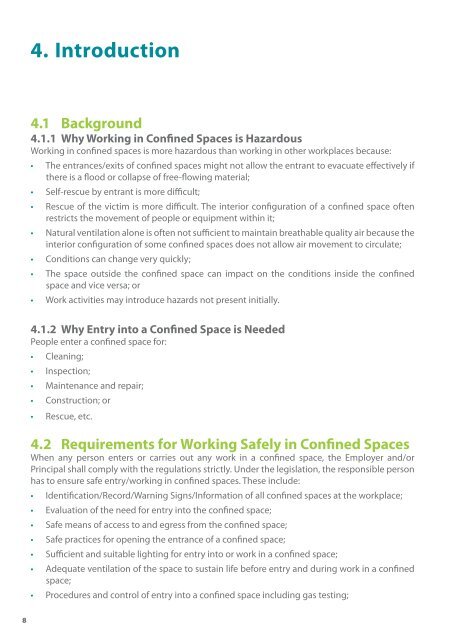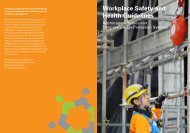Confined Spaces - Workplace Safety and Health Council
Confined Spaces - Workplace Safety and Health Council
Confined Spaces - Workplace Safety and Health Council
- No tags were found...
You also want an ePaper? Increase the reach of your titles
YUMPU automatically turns print PDFs into web optimized ePapers that Google loves.
4. Introduction4.1 Background4.1.1 Why Working in <strong>Confined</strong> <strong>Spaces</strong> is HazardousWorking in confined spaces is more hazardous than working in other workplaces because:• The entrances/exits of confined spaces might not allow the entrant to evacuate effectively ifthere is a flood or collapse of free-flowing material;• Self-rescue by entrant is more difficult;• Rescue of the victim is more difficult. The interior configuration of a confined space oftenrestricts the movement of people or equipment within it;• Natural ventilation alone is often not sufficient to maintain breathable quality air because theinterior configuration of some confined spaces does not allow air movement to circulate;• Conditions can change very quickly;• The space outside the confined space can impact on the conditions inside the confinedspace <strong>and</strong> vice versa; or• Work activities may introduce hazards not present initially.4.1.2 Why Entry into a <strong>Confined</strong> Space is NeededPeople enter a confined space for:• Cleaning;• Inspection;• Maintenance <strong>and</strong> repair;• Construction; or• Rescue, etc.4.2 Requirements for Working Safely in <strong>Confined</strong> <strong>Spaces</strong>When any person enters or carries out any work in a confined space, the Employer <strong>and</strong>/orPrincipal shall comply with the regulations strictly. Under the legislation, the responsible personhas to ensure safe entry/working in confined spaces. These include:• Identification/Record/Warning Signs/Information of all confined spaces at the workplace;• Evaluation of the need for entry into the confined space;• Safe means of access to <strong>and</strong> egress from the confined space;• Safe practices for opening the entrance of a confined space;• Sufficient <strong>and</strong> suitable lighting for entry into or work in a confined space;• Adequate ventilation of the space to sustain life before entry <strong>and</strong> during work in a confinedspace;• Procedures <strong>and</strong> control of entry into a confined space including gas testing;• <strong>Safety</strong> <strong>and</strong> health training on working in confined spaces for workers <strong>and</strong> supervisors;• Emergency rescue operations in confined spaces which include the establishment of a rescueplan <strong>and</strong> provision of rescue equipment for confined space;• Appointment of a confined space attendant; <strong>and</strong>• The worker is fit to work in confined spaces.4.3 Types of InjuryAccording to <strong>Workplace</strong> <strong>Safety</strong> & <strong>Health</strong>, 2008: National Statistics, about 10% of workplacefatalities in 2008 were related to accidents in confined spaces.2008 2007Total 67 63Falls from height 19 23Struck by falling objects• Due to collapse or failure of structure <strong>and</strong> equipment• From heightsStruck by moving objects• By prime movers/trailers/roll-on bin truckFires <strong>and</strong> explosions• Occuring in confined spacesCaught in between objects 4 5Electrocution 4 2Collapse of tower crane 3 0Slips <strong>and</strong> trips 2 2Other incident types (e.g., drowning, exposure to heat) 0 5Figure 1: Number of workplace fatalities by type of incident, 2007 <strong>and</strong> 2008 (<strong>Workplace</strong> <strong>Safety</strong> & <strong>Health</strong>,2008: National Statistics).The types of injuries relevant to confined space accidents include:• Injuries arising from fire <strong>and</strong> explosion;• Loss of consciousness or asphyxiation arising from harmful gases, vapours or fumes, freeflowing solids or lack of oxygen;• Drowning arising from an increase in level of liquid;• Heat-related disorders;• Electrocution;• Physical contact with moving or rotating parts; <strong>and</strong>• Falls from height.148612553125752738 9
















